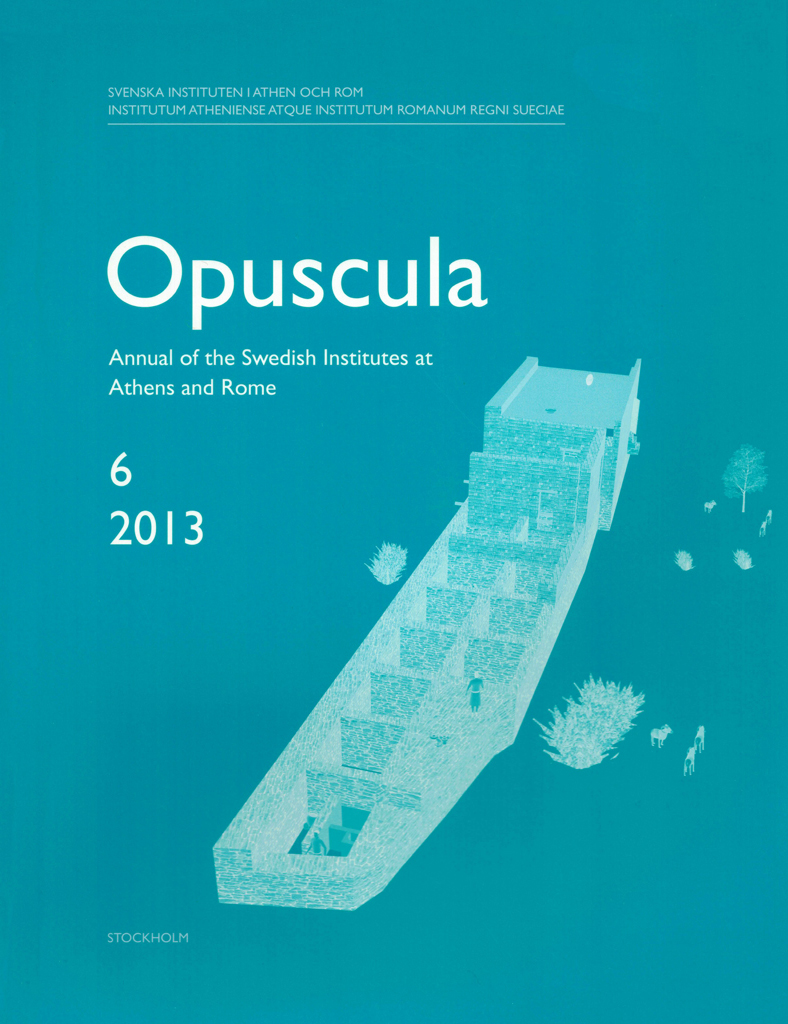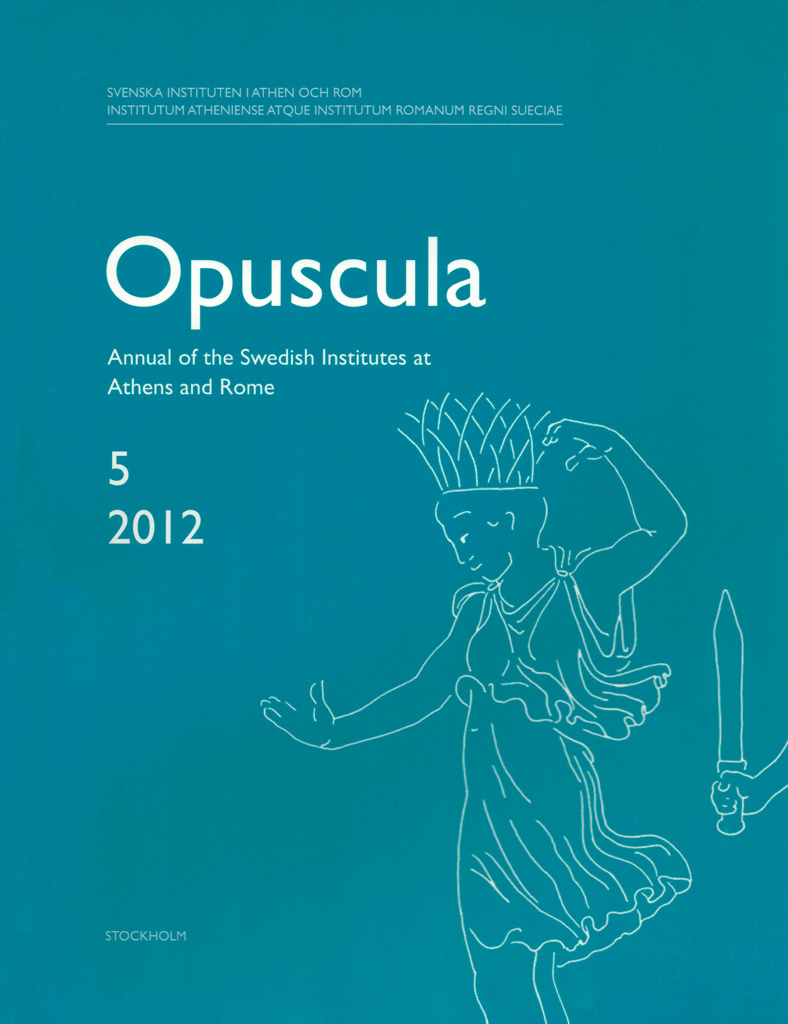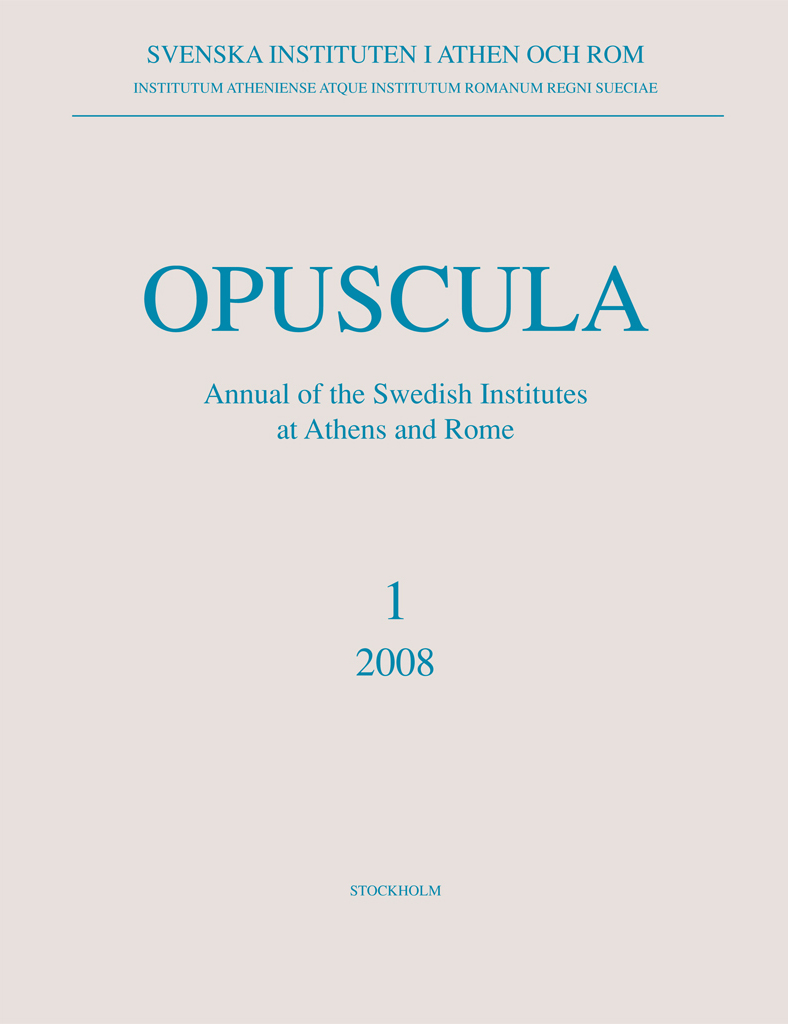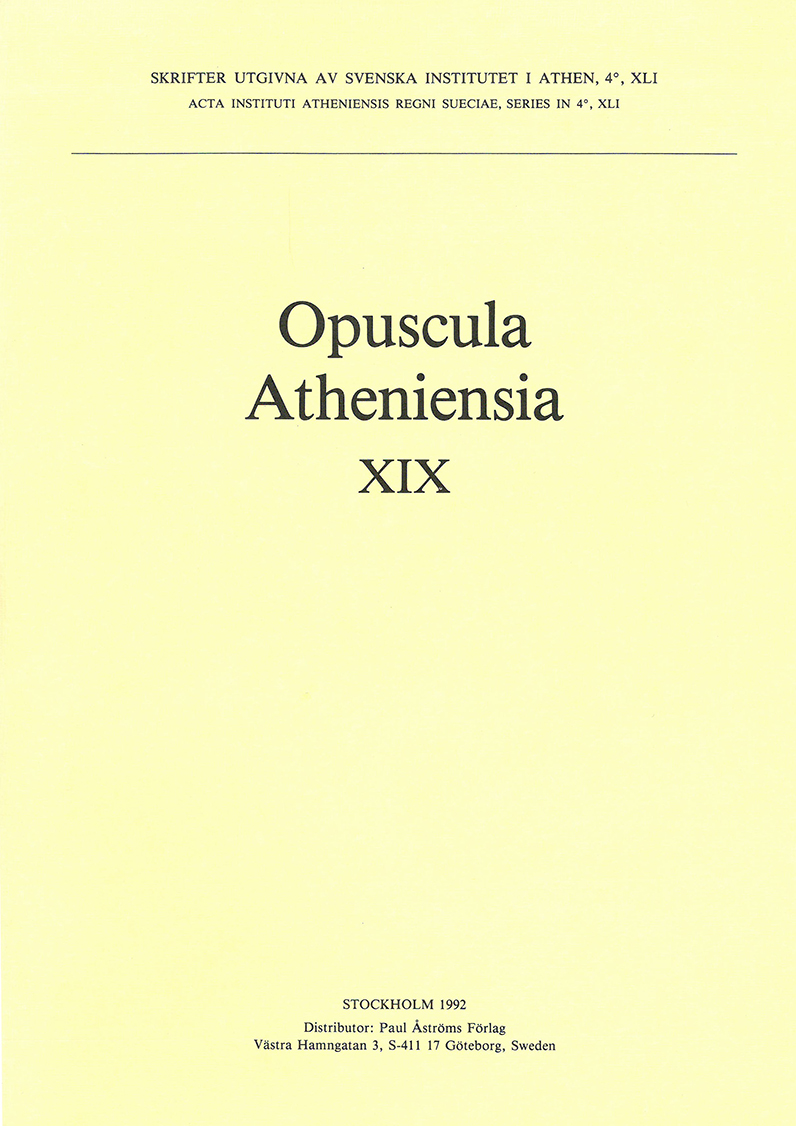Opuscula 7 (2014) is now available for purchase and free download at Bokorder.se. Also available at Amazon.com, Amazon.de, Bokus.com and Adlibris.com. The New Swedish Cyprus Expedition 2013. Excavations at Hala Sultan Tekke. Preliminary results. By Peter M. Fischer & Teresa Bürge. With contributions by R. Árnadóttir, M. Mehofer, F. Köstelbauer, A. Satraki, L. Mazzotta, A. Trecarichi, D. Blattner, B. Stolle, & A. Miltiadous Johansson Abstract The results from a 1.3-hectare GPR survey in 2012 were confirmed during the 2013 excavation of a limited area (200 m2). Three phases of occupation were partly exposed. The most recent phase, Stratum 1, contained living and working facilities, e.g. for spinning, weaving and purple dyeing. Textile production also took place in the older Stratum 2, where the major activity was metal-working: 300 kg of remains from copperworking consist of tapped slag, furnace walls, fragments of at least five tuyères, crucible fragments, copper/bronze fragments and pieces of raw copper. Another of these unique kraters of White Painted Wheel-made Pictorial Style (WPPS) was found. It was termed “Horned God Krater” on account of one of the decorative elements. These kraters may indicate that there was a “Hala Sultan Tekke painter”. The oldest phase of occupation so…
Opuscula 6 (2013) is now available for purchase and free download at Bokorder.se. Also available at Amazon.com, Amazon.de, Bokus.com and Adlibris.com. The Swedish Jordan Expedition 2011 and 2012 at Tall Abu al-Kharaz. Preliminary results from the early Iron Age occupation in Area 9 By Peter M. Fischer & Teresa Bürge. With contributions by D. Blattner, M. Alrousan & A. Abu Dalo Abstract Tall Abu al-Kharaz, a twelve hectare-large tell in the central Jordan Valley, was occupied for approximately five millennia. In earlier excavation seasons most of the early Iron Age remains were found to have been disturbed by later settlers. Between 2009 and 2012 excavations revealed an extremely well-preserved city quarter dating from around 1100 BC, which represents an essential part of the settlement history of this city. The stone-built architectural compound consists of 21 rooms, with walls still standing to a height of more than 2 m. The inventories of these rooms, which comprised more than 200 complete vessels and other objects, were remarkably intact. Amongst the finds were imports from Egypt and Phoenicia. There were also finds which are associated with the culture of the Sea Peoples/Philistines, such as several Aegean and Cypriote-style vessels and other objects. The…
Opuscula 6 (2013) is now available for purchase and free download at Bokorder.se. Also available at Amazon.com, Amazon.de, Bokus.com and Adlibris.com. The New Swedish Cyprus Expedition 2012. Excavations at Hala Sultan Tekke. Preliminary results By Peter M. Fischer & Teresa Bürge. With contributions by I. Trinks, B. Stolle, K. Heiß, J.A.I. van der Does & D.M. Blattner Abstract The third season of excavation at Hala Sultan Tekke added knowledge to the project, the main objective of which is the investigation and determination of the complete occupational sequence of the pre-12th century BC levels. New walled and open spaces from Strata 1 and 2 were exposed in Area 6. Another pictorial krater with birds was excavated. The terminology for the much discussed Cypriote-produced White Painted Wheel-made ware has been revised and a new terminology is suggested, i.e. “White Painted Wheel-made Geometric Style (WPGS)” and “White Painted Wheel-made Pictorial Style (WPPS)”, of which the latter includes the Creature Krater from 2010 and the Bird Krater from this season. The hypothesis that a tsunami destroyed parts of the city in the 14th or 13th century BC is discussed. An additional radar survey of some 1.3 hectares revealed substantial structures, i.e. new city quarters,…
Opuscula 5 (2012) is now available for purchase and free download at Bokorder.se. Also available at Amazon.com, Amazon.de, Bokus.com, and Adlibris.com. The Swedish Jordan Expedition 2009 and 2010 at Tall Abu al-Kharaz. Preliminary results from the Early Iron Age occupation in Area 9. With appendices by T. Bürge, and A. Gustafsson & J. Azzopardi By Peter M. Fischer Abstract Tall Abu al-Kharaz, in the central Jordan Valley, was occupied during approximately five millennia. A walled town, which had a dominant position in the Jordan Valley, existed already in the Early Bronze Age IB, viz. before 3050 BC. Walled settlements also flourished at the end of the Middle Bronze Age (around 1600 BC), during the Late Bronze Age (roughly 1500–1200 BC) and throughout the entire Iron Age (roughly 1200–600 BC). It is most likely that Tell Abu al-Kharaz is identical with Jabesh Gilead: this city is mentioned frequently in the Old Testament. During earlier seasons most of the Early Iron Age remains were found to have been disturbed by later settlers. It is, therefore, essential for the documentation of the settlement history of this city, that the expedition of 2009 unearthed an extremely well-preserved city quarter dating to the 12/11th century…
Opuscula 5 (2012) is now available for purchase and free download at Bokorder.se. Also available at Amazon.com, Amazon.de, Bokus.com, and Adlibris.com. The New Swedish Cyprus Expedition 2011. Excavations at Hala Sultan Tekke. Preliminary results. With appendices by T. Bürge, L. Franz and R. Feldbacher By Peter M. Fischer Abstract The main objective of the excavations of the Late Cypriote city of Hala Sultan Tekke is the investigation and determination of the complete occupational sequence of the pre-12th century levels. The groundpenetrating radar survey (GPR) led to the discovery and excavation of numerous rooms of a large Late Cypriote complex. During the second year of excavations at the site the expedition exposed a third phase of occupation (Stratum 3). A Stratum 2 compound, with extraordinarily wide walls was uncovered in the eastern part of the excavations. Intact vessels include Base-ring I and II, and White Painted VI, and Late Helladic imports. Other wares include: White Painted Pendant/Cross Line Style, Red-on-Black/Red, Bichrome Wheel-made, White Slip I and II, Monochrome, Base-ring I and II, Red Lustrous Wheel-made, White Painted/Plain-White Wheel-made, and White Shaved. Unique discoveries amongst the small finds are a haematite cylinder seal and a stone pendant figurine. The numerous tools related…
Opuscula 4 (2011) is now available for purchase and free download at Bokorder.se. Also available at Amazon.com, Amazon.de, Bokus.com, and Adlibris.com. The New Swedish Cyprus Expedition 2010. Excavations at Dromolaxia Vizatzia/Hala Sultan Tekke. Preliminary results. With appendices by P. Klingborg, F. and F. Kärfve, C. Hagberg, O. Svensson, S. Macheridis and L. Franz By Peter M. Fischer, with appendices by P. Klingborg, F. Kärfve, F. Kärfve, C. Hagberg, O. Svensson, S. Macheridis, L. Franz Abstract Determination of the complete occupational sequence of the site, including investigation of pre-12th century levels which were thoroughly studied by P. Åström since the 1970s, is the main task of the planned project. During the course of the expedition (NSCE11) in spring 2010 a ground-penetrating radar survey (GPR) was carried out at Dromolaxia Vizatzia/Hala Sultan Tekke in Area 6, leading to the discovery of a large Late Cypriote complex. The compound is bordered to the north by a substantial wall, against which nine rooms (so far) could be exposed. Two occupational phases have been verified but there are indications of a third. The suggested functions of the various structures of the most recent phase are: living, working, storage and administration spaces. The rich find contexts…
Opuscula 1 (2008) is out of print. Available for free download at Bokorder.se. Used copies might be available at Amazon.com and Amazon.de. Paul Åström (1929–2008)—The Swedish nestor of archaeology By Peter M. Fischer https://doi.org/10.30549/opathrom-01-14 Paul Åström in memoriam 1929–2008 By Ann-Louise Schallin https://doi.org/10.30549/opathrom-01-15 Tullia Linders (1925–2008) By Gullög Nordquist https://doi.org/10.30549/opathrom-01-16 These contributions are only available in print. Bibliographical information ‘In memoriam’, Opuscula. Annual of the Swedish Institutes at Athens and Rome (OpAthRom) 1, 179–184. Stockholm 2008. ISSN: 2000-0898. ISBN: 978-91-977798-0-7. Softcover, 198 pages.
Published by the Swedish Institute at Athens. Distributed by Astrom Editions. Opuscula Atheniensia 19 Contents Carl Nylander, ‘Sture Brunnsåker, 1925–1978’ (p. 9) Paul Åström, Katie Demakopoulou, Nicoletta Divari-Valakou & Peter M. Fischer, ‘Excavations in Midea, 1989–1990’ (pp. 11–22) Gisela Walberg, ‘Excavations on the Lower Terraces at Midea’ (pp. 23–39) Birgitta Bergquist, ‘A particular, Western Greek cult practice? The significance of stele-crowned, sacrificial deposits’ (pp. 41–47) Mary Blomberg, ‘The meaning of Χελιδών in Hesiod’ (pp. 49–57) Robin Hägg & Gullög C. Nordquist, ‘Excavations in the Levendis sector at Asine, 1989. A preliminary report with an appendix on the animal bones by Katrin Moberg’ (pp. 59–68) Tullia Linders, ‘The Delian temple accounts: some observations’ (pp. 69–73) Alexandros Mazarakis Ainian, ‘Nichoria in the south-western Peloponnese: Units VI-1 and IV-5 reconsidered’ (pp. 75–84) Erik Østby, ‘Der dorische Tempel von Pherai’ (pp. 85–113) Paul Rehak, ‘Minoan vessels with figure-eight shields: antecedents to the Knossos throneroom alabastra’ (pp. 115–124) Eva Rystedt, ‘Notes on the rattle scenes on Attic Geometric pottery’ (pp. 125–133) Berit Wells, ‘The walls of Asine’ (pp. 135–142) Charlotte Wikander, ‘Pomp and circumstance. The procession of Ptolemaios II’ (pp. 143–150) Örjan Wikander, ‘Archaic roof-tiles: the first (?) generation’ (pp. 151–161) Miscellanea Åke Åkerström (†),…
Published by the Swedish Institute at Athens. Distributed by Astrom Editions. Opuscula Atheniensia 18 Edited by Brita Alroth Contents Paul Åström, Katie Demakopoulou, Nicoletta Divari-Valakou, Peter M. Fischer & Gisela Walberg, ‘Excavations in Midea 1987’, 9–22. Birgitta Bergquist, ‘Primary or secondary temple function: the case of Halieis’, 23–37. Danali-Giole, ‘Ikonographische Beobachtungen zu drei Mythologischen Themen: Pentheus, Phineus, Prometheus’, 39–44. Søren Dietz & Nicoletta Divari-Valakou, ‘A Middle Helladic III/Late Helladic I grave group from Myloi in the Argolid (Oikopedon Manti)’, 45–62. Carole S. Gillis, ‘Statistical analyses and conical cups. A preliminary report from Akrotiri, Thera’, 63–93. Robin Hägg, ‘The Cretan hut-models’, 95–107. Bernard Knapp, ‘Copper production and Mediterranean trade: the view from Cyprus’, 109–116. A.A.D. Peatfield, ‘Minoan peak sanctuaries: history and society’, 117–131. Francis Piejko, ‘To the inscriptions of Labraunda’, 133–156. Gery de Pierpont, ‘Aegean jewellery: a new approach to a typology. Application on gold and silver Minoan jewellery (2700–1450)’, 157–165. Eva Rystedt, ‘On distinguishing hands in Mycenaean pictorial vase-painting’, 167–176. Eva Rystedt, ‘Die Wagenfriese der attischen geometrischen Keramik und die Frage ihrer Ablesung. Vorläufige Bemerkungen anlässlich einer Vase im Louvre’, 177–183. Charlotte Scheffer, ‘“Domus Regiae”—a Greek tradition?’, 185–191. Peter Warren, ‘Of baetyls’, 193–206. Berit Wells, Curtis Runnels & Eberhard Zangger,…







